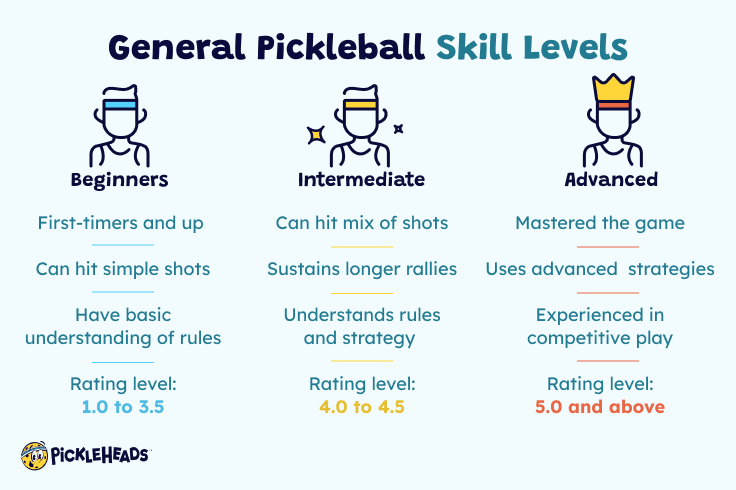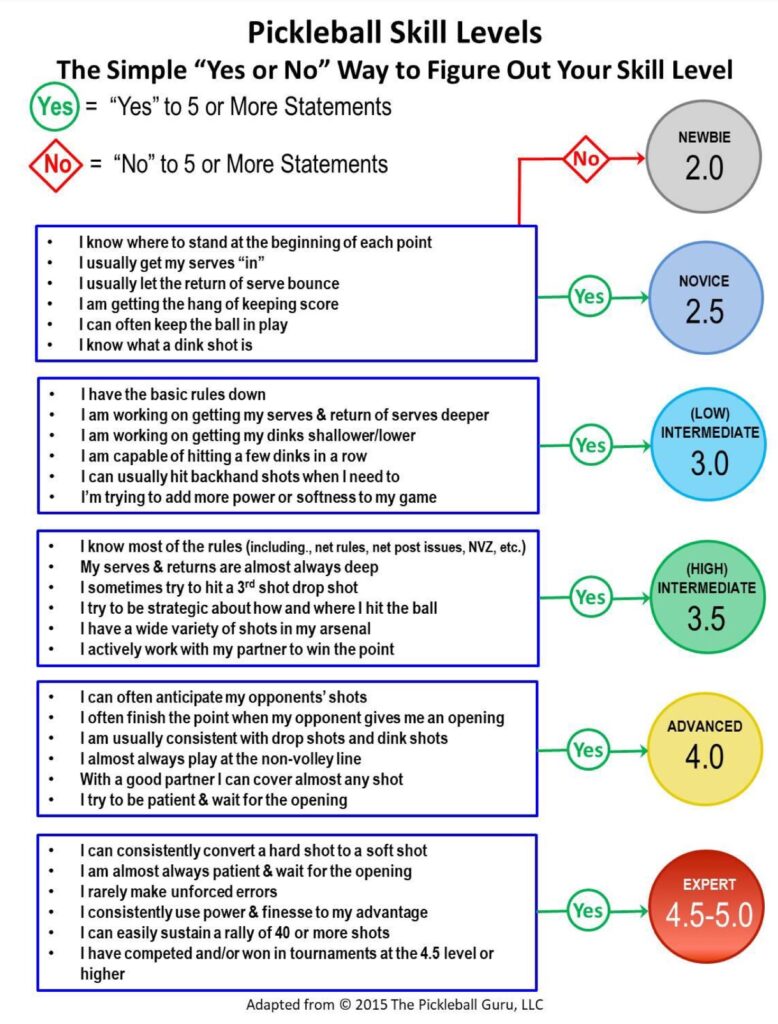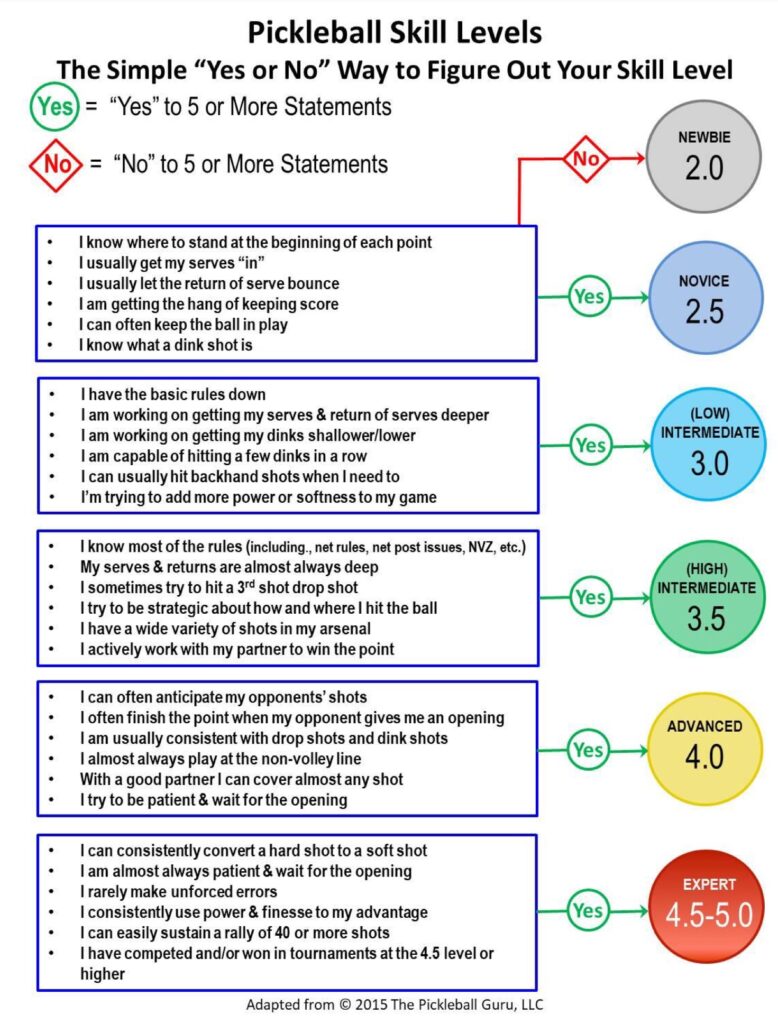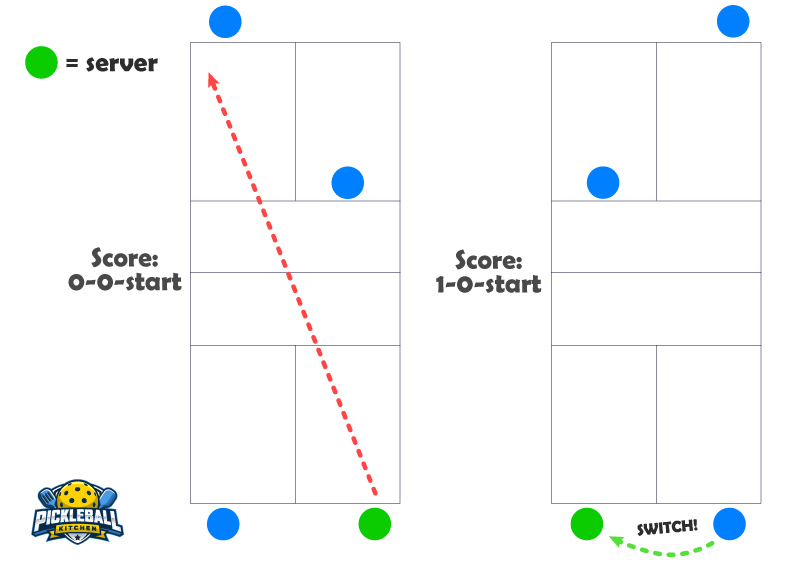Pickleball has three main levels: beginner, intermediate, and advanced. In the beginner level, players focus on learning the basic rules, techniques, and strategies of the game.
The intermediate level is for players who have mastered the fundamentals and are ready to enhance their skills and compete at a higher level. Advanced players are highly skilled and experienced individuals who can play at a competitive level and participate in tournaments.
Each level offers a different level of challenge and requires players to continuously improve their game. Whether you are just starting or have been playing for years, there is a level of pickleball that suits your skills and abilities.
Beginner Level

Welcome to the beginner level of pickleball! If you are new to this exciting sport or just starting out, this is the perfect place for you. In this section, we will cover the basics of pickleball, as well as the key skills and techniques that beginners should focus on. Let’s dive in and get you on your way to becoming a skilled pickleball player!
Basics Of Pickleball
Before we delve into the skills and techniques, let’s familiarize ourselves with the basics of pickleball. Pickleball is a paddle sport that combines elements of tennis, badminton, and table tennis. It is played on a smaller court with a perforated plastic ball and a paddle. The objective is to hit the ball over the net and into the opponent’s court without them returning it.
Here are some key points to remember:
- Pickleball can be played in singles or doubles format
- The serving team must start the game by serving diagonally
- Only the serving team can score points
- Points are earned by forcing faults or hitting shots that cannot be returned
- The first team to reach 11 points, with a lead of at least 2 points, wins the game
Skills And Techniques For Beginners
Now that you have a good understanding of the basics, let’s focus on the key skills and techniques that will help you excel as a beginner. Remember, practice makes perfect, so don’t be afraid to spend time honing your skills.
Serving
The serve is a crucial aspect of pickleball and can often determine the outcome of a game. As a beginner, you should focus on developing consistent and accurate serves. Start by practicing the underhand serve, which is the most common technique used in pickleball. Aim to keep your serves low and near the center of the court to give your opponent less time to react.
Volleys
Mastering volleys is another important skill for beginners. Volleys involve hitting the ball before it bounces on your side of the court. Practice positioning yourself near the non-volley zone and work on your hand-eye coordination to successfully execute volleys. Focus on making soft, controlled shots to keep the ball in play and put pressure on your opponent.
Dinks
Dinks are short, controlled shots that are played close to the net. These shots require finesse and touch, rather than power. As a beginner, work on your dinking technique to place the ball precisely and force your opponent into making errors. Keep the ball low and soft, ensuring it clears the net and lands in the opponent’s non-volley zone.
Footwork
Effective footwork is essential for moving quickly and efficiently around the court. As a beginner, focus on maintaining a wide and balanced stance, with your weight evenly distributed. Practice shuffling your feet to get into the optimal position for each shot and react quickly to your opponent’s shots.
By developing these core skills and techniques, you will build a solid foundation as a pickleball player. Remember to practice regularly, seek guidance from experienced players, and most importantly, have fun! In the next section, we will explore the intermediate level of pickleball.

Credit: www.paddletek.com
Intermediate Level
Once you’ve gained a solid foundation in the basics of pickleball, it’s time to take your skills to the next level and move on to the intermediate level. At this stage, you should be comfortable with the rules and basic strokes of the game. Now it’s time to focus on refining your techniques, improving consistency, and developing advanced strategies to enhance your gameplay.
Advanced Techniques And Strategies
As an intermediate player, it’s important to start incorporating advanced techniques and strategies into your gameplay. These techniques can help you gain an advantage on the court and outsmart your opponents. Here are a few key techniques and strategies to focus on:
- Serve Placement: Experiment with different serve placements to keep your opponents on their toes. Aim for the corners of the court to make it more difficult for them to return your serve.
- Dinking: Master the art of dinking, which involves hitting the ball softly over the net, close to the net. This can be an effective strategy to force your opponents into making mistakes or setting up a winning shot.
- Third Shot Drop: Practice the third shot drop, which involves hitting a soft, high-arcing shot to the opponents’ non-volley zone after your return of serve. This strategic shot can give you more control and set you up for a better position in the rally.
- Offensive and Defensive Positioning: Learn how to position yourself strategically on the court based on whether you’re on the offensive or defensive. Understanding where to stand can help you anticipate your opponent’s shots and improve your court coverage.
- Attacking Shots: Experiment with different attacking shots, such as volleys, smashes, and lobs, to put pressure on your opponents and take control of the point.
Improving Consistency And Accuracy
Consistency and accuracy are crucial in pickleball, and as an intermediate player, it’s essential to work on improving these aspects of your game. Here are some tips to help you enhance your consistency and accuracy:
- Practice Regularly: Dedicate time to practice regularly and focus on drills that improve your control and accuracy.
- Focus on Footwork: Pay attention to your footwork and ensure you’re in the correct position to make accurate shots.
- Develop a Reliable Stroke: Work on developing a repeatable stroke technique for each shot to increase your consistency.
- Slow Down Your Game: Sometimes, slowing down your game can help you make more precise and accurate shots. Take your time and focus on hitting the ball cleanly.
- Play Doubles: Playing doubles pickleball can help you develop your consistency and accuracy as you have to work in sync with your partner.
Advanced Level
At the advanced level of pickleball, players have honed their skills and are ready to take their game to the next level. This level is marked by a deeper understanding of the game, strategic shot placement, and the ability to compete at a higher level. In this section, we will explore the various aspects of the advanced level in pickleball.
Mastering Advanced Shots
Mastering advanced shots is a key component of excelling at the advanced level of pickleball. Players at this level have worked hard to perfect their techniques and are able to execute a wide range of shots with precision. Some advanced shots that players focus on include:
- Dinking: A soft shot that is played close to the net, designed to force opponents into making an error or to set up an attacking opportunity.
- Volleys: Quick wrist action and accurate placement are crucial for successful volleys, which are shots that are hit in the air before the ball bounces.
- Third-shot drops: A shot that is aimed to land softly in the opponent’s kitchen area, often utilized after a serve and return to gain control of the net.
- Smashes: A powerful overhead shot that is used to put pressure on the opponents and end the point.
By mastering these advanced shots, players are able to add a new level of finesse and control to their game. These shots require quick reflexes, precise placement, and a deep understanding of the opponent’s positioning.
Competing At A Higher Level
Competing at a higher level is the ultimate goal for many pickleball players. At the advanced level, players have the opportunity to participate in competitive events and face off against skilled opponents. This level of play requires a strong mental game, adaptability, and the ability to read the opponent’s moves.
Players at the advanced level focus on developing strategies to outsmart their opponents. They analyze their opponent’s strengths and weaknesses, adjust their gameplay accordingly, and make quick decisions on which shots to play. The advanced level also introduces more advanced game tactics, such as stacking, poaching, and controlling the pace of the game.
Competition at the advanced level is intense and often requires players to be in top physical condition. Endurance, agility, and speed are essential for lasting through long matches and keeping up with the fast-paced nature of the game.

Credit: www.pickleheads.com
Frequently Asked Questions On What Are The Levels Of Pickleball
What Does A 3.0 Pickleball Player Mean?
A 3. 0 pickleball player refers to an intermediate level player who has basic skills and knowledge of the game. They are able to consistently hit the ball over the net but may struggle with advanced techniques and strategies.
How Do You Know If You’re A 4.0 Pickleball Player?
To determine if you’re a 4. 0 pickleball player, assess your skill level, technique, and knowledge of the game. Consider your ability to consistently execute advanced shots, control the ball, and strategize in various game situations. Engage in competitive play against other players and seek feedback from experienced players for an accurate evaluation.
How Many Levels Are There In Pickleball?
Pickleball has four levels: beginner, intermediate, advanced, and professional.
What Is A 2.5 Level Pickleball Player?
A 2. 5 level pickleball player refers to a player who is still in the early stages of learning the game. They have basic knowledge of the rules and limited experience in playing. However, they are still working on their skills and developing their technique.
Conclusion
To summarize, understanding the different levels of pickleball is crucial for players of all skill levels. Whether you’re a beginner looking to delve into the basics or an advanced player striving for more competitive matches, knowing where you stand and how to progress will significantly enhance your game.
By familiarizing yourself with the various skill levels and continuously challenging yourself to improve, you’ll take your pickleball journey to new heights. Start now and enjoy the thrilling experience this sport offers. Reach new levels, challenge opponents, and embrace the excitement of pickleball.
Neil jacobson is an avid Pickleball enthusiast, writer, and coach dedicated to sharing the joy and intricacies of the sport. With 6 years of experience on the court and a passion for teaching, Courtney brings a unique perspective to his writing, offering practical insights and strategies for players of all levels. As a certified Pickleball coach, his mission is to inspire and empower individuals to excel in the game while fostering a sense of community within the Pickleball world. Through his articles, guides, and coaching sessions, Neil aims to elevate the playing experience and share the infectious enthusiasm that defines the Pickleball community.



